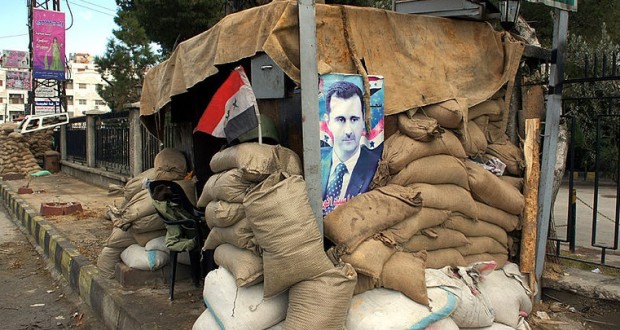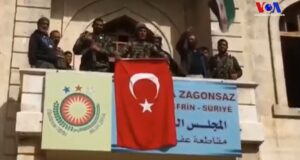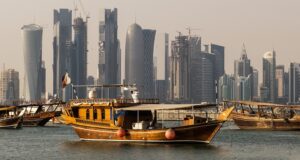Rowan Allport, Senior Fellow – Human Security Centre
21 October 2014, Security and Defence, Issue 4, No. 4.
The commencement of air strikes against the assets of ISIS in Syria last month marked the opening of the US-led coalition’s second front against the extremist group. The assault began with a wave of US Tomahawk cruise missile attacks against ISIS facilities, and was followed up by raids using both manned aircraft and unmanned aerial combat vehicles. Bahrain, Jordan, Qatar, Saudi Arabia and the United Arab Emirates also contributed aircraft to the operation. In addition to ISIS, a group of apparent Al Qaeda operatives that were providing support to the Islamist Jabhat al-Nusra rebel group was also targeted.
The US air operation in Syria has proven to be considerably more substantial than I originally predicted in June following the fall of Mosul. This mismatch can be at least partly explained by the fact that US public opinion has shifted massively in favour of intervention against ISIS, principally as a result of the beheadings of a number of US citizens and other Westerners. With greater public support for action has come increased tolerance for risk – although the US military has also taken precautions in the form of the use of stealth aircraft and the deployment of air defence suppression assets in case the remnants of Assad’s air defence system attempt to intervene in the strikes. British public opinion has also moved towards supporting attacks on ISIS in Syria, and it is possible that a second parliamentary vote will be held to authorise UK intervention in the country.
The ISIS crisis in Syria continues to run in parallel to its counterpart in Iraq. Politically, the latter country now has a new prime minister, Haider al-Abbadi, and a new government that has a Sunni, Khaled al-Obeidi, in the the key position of defence minister: a vital concession to the minority Sunnis, given the mistreatment they have suffered at the hands of Iraqi Security Forces. Militarily, however, the situation remains grim. The advance of ISIS fighters continues – albeit at a slowed pace – even though the UK, France and a number of other Western nations have joined the US-led air operation against them. There is also little sign that the Iraqi military is in any state to stage a counter offensive. Just before the UK’s parliamentary vote on military action in Iraq in September, the BBC’s political editor was apparently informed that the initial military goal was the recapture of Mosul in late October or early November of this year. Such thinking would appear to have reflected a belief at the time amongst some military planners that the operation against ISIS could accomplish a repeat of the fall of Kabul in 2001, where an air campaign allowed a combination of local units and a small number of Western Special Forces to capture the Afghan capital from the Taliban in little over a month. However, much of that accomplishment must be put down to the motivated fighters of the Northern Alliance and the fact that at the time, the Taliban had little experience of fighting an enemy with the US’s level of technology. Given the “psychological collapse” of much of the Iraqi Army and an enemy that is both familiar with US abilities and has a level of fanaticism that puts even the Taliban in the shade, emulating the Afghan successes of 2001 has proved to be wishful thinking. It is now painfully apparent that a long and grinding operation that will take several years to rebuild the Iraqi military whilst simultaneously degrading ISIS forces through a campaign of attrition will be required. This fact was echoed in comments made by retired General John R. Allen, who is coordinating the operation, just two weeks after the optimistic pronouncement of the British official: he believes it could take up to a year just to recapture Mosul from ISIS. Strategically, even this would likely be in vain if it proves impossible for true reconciliation between Iraq’s sectarian groups to take place.
However, one advantage the conflict with ISIS in Iraq does have over the conjoined war in Syria is that it is at least viable for the West to work with the existing government. To the west of the Sykes-Picot line, it is not only necessary to defeat ISIS, but also desirable to eliminate a regime in Damascus which is guilty of both crimes against humanity of epic proportions in its own right, and facilitating the rise of ISIS in the first place. The need, therefore, is for a two stage operation that would both liberate north-east Syria from ISIS and then remove the current Syrian government. Theoretically, the Syrian component of the current Obama plan does in fact offer a springboard from which to accomplish both goals.
As things stand, it is currently intended that – as in Iraq – Western-led air strikes in Syria will seek to hamper the activities of ISIS over the coming months. The second phase of the operation is intended to see the US and its allies train (most likely in Turkey) a force of moderate Syrian rebels in order to facilitate a ground offensive against ISIS. However, this scheme presents a significant number of challenges. There are serious questions regarding who would exercise political leadership of this formation. Even if this were resolved, it is unknown how other rebel groups would react to the initiative: already, it has been reported that the Al Qaeda-linked Jabhat al-Nusra has begun reconciliation talks with ISIS as a result of the US-led bombing campaign. How the Kurds would position themselves is also open to question. Finally, there is the major issue of whether it will prove possible to persuade a sufficient number of rebels to prioritise the defeat of ISIS over the war against Assad. Whilst current assumptions are that an initial force of 5,000 ‘vetted’ personnel – which would eventually grow to be around 15,000 strong – would be needed to drive ISIS from its Syrian territory, this is probably a substantial underestimation of the actual requirement. In truth, around 30,000 fighters would likely be needed to clear and secure the territory in question. It is also almost certain that such an effort would, in addition to air support, demand a significant presence of allied Special Forces and other support personnel on the ground within Syria.
An even more pressing concern is the attitude of the Assad regime. Any attempt by hostile foreign powers to establish a genuine alternative to the Damascus government and its armed forces within Syria would represent an existential threat to its hold on power. However, the allied-trained units would have to be free to operate against ISIS without interference from the Syrian regime. As the West has experienced in Iraq and Afghanistan, fighting Islamic extremists is difficult enough even with total air superiority and when the enemy lacks heavy weapons: being interrupted by third party air and armoured raids would make the job of engaging ISIS impossible for a free Syrian force. As such, it would probably be necessary to establish an air and ground exclusion zone in north-east Syria, with any government forces attempting to enter the area being subjected to US and allied air attack. As well as the military component of the anti-ISIS operation, it would also be vital to restore basic services and some form of government in liberated areas in order to win over the population from an enemy that has become relatively adept regarding at least some elements of hearts and minds strategy. Ultimately, it seems that little short of a statelet would need to be created in north-east Syria for US plans to have any hope of success.
It is probably realistic to assume that if (and it is a huge ‘if’) an expanded version of the planned training programme and military/civilian effort is effectively implemented and not excessively hampered by political and military divisions within the moderate Syrian opposition and allied camps, it should be possible to accomplish the goal of reducing the presence of ISIS in Syria to a ‘manageable’ level in roughly four years. But what then? In the background of the anti-ISIS campaign, the wider civil war in Syria would almost certainly have continued to drag on. With ISIS adequately suppressed, protection from Assad in the territory already controlled by a free Syrian force supplied by Western air power and – presumably – some sort of alternative government established, would the natural next step not be for anti-Assad forces to march on Damascus and ‘finish the job’?
The decision over a final push to remove Assad would lie with Washington. The caution of the Obama administration over Syria has so far proven disastrous, serving only to make inevitable the very nightmare the US sought to avoid. But a key point of the Obama plan is that, due to the timescale involved, it is virtually impossible to envisage the defeat of ISIS in Syria during his remaining two years in the White House. The beginning of 2017 will see a new president – currently overwhelmingly likely to be former Secretary of State Hillary Clinton – inaugurated into office. Whilst a key actor behind the intervention in Libya and a critic of Obama’s inaction in Syria, it would be wrong to refer to Clinton as a foreign policy ‘hawk’ in the sense that commentators on both the hard left and hard right of US politics seem to have developed a habit of doing. However, her self-declared stance of ‘idealistic realism’ would likely make her more receptive to a policy that would aim for the outright overthrow of Assad: particularly if – unlike in the messy aftermath of the removal of Colonel Gaddafi – a viable alternative government and security force were available to take the reins. As a result, a pro-active operation in the mould of the 2011 Libya campaign to support an allied-trained free Syrian ground force in removing the existing regime would be a distinct possibility post-2016. Whilst in theory such action would require the approval of the UN Security Council, the degree to which veto-wielding Russia’s attitude towards even the UN appears to be increasingly sourced from a fantasy land of the Kremlin’s own creation would likely persuade many that such authorisation is as unnecessary as it is implausible.
An extension of the currently planned anti-ISIS operation in Syria to encompass eventual regime change in Damascus is highly ambitious and fraught with risk. It would of course not be as simple as capturing a city and obtaining a signature of surrender. The potential for sectarian violence to overwhelm the country would be huge: in particular, it would probably be necessary to deploy an international ground force to protect the country’s Alawite community (which forms much of Assad’s power base) from post-war reprisal attacks. Disarming the array of militias that have sprung up during the course of the war would be extremely challenging. Even ignoring the security issues, the reconstruction of Syria would take decades and cost hundreds of billions of dollars. But with no realistic chance of peace with the current government still in power, drastic action to radically change the dynamic in a war that has so far killed over 200,000 people might come to be viewed as the only viable way ahead.
Rowan Allport is a Senior Fellow at the Human Security Centre
He is contactable at:
Rowan.allport@hscentre.org
Please cite this article as:
Allport, R (2014). ‘Syria: A New Way Ahead?’ Human Security Centre, Security and Defence. Issue 4, No. 4.
 Human Security Centre Human Rights and International Security Research
Human Security Centre Human Rights and International Security Research




